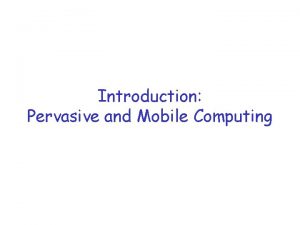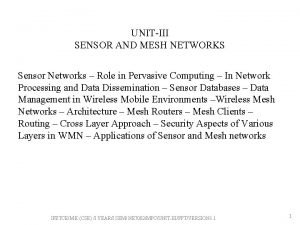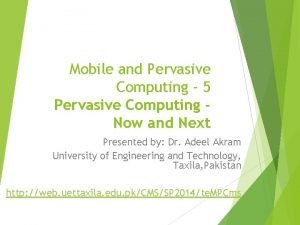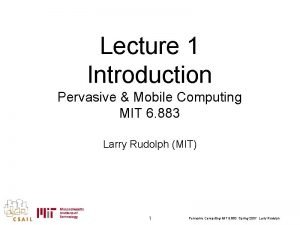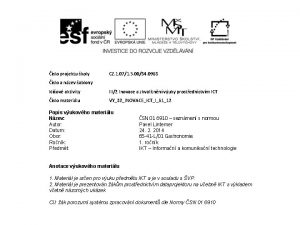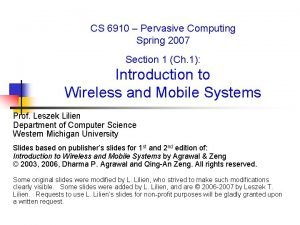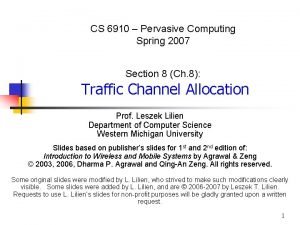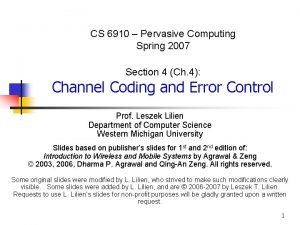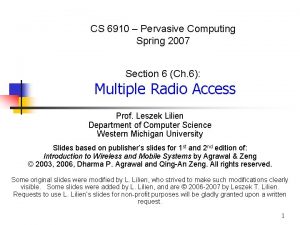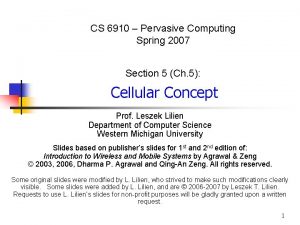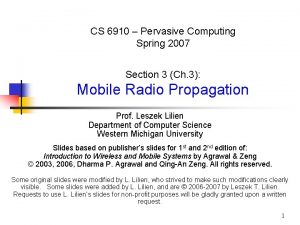CS 6910 Pervasive Computing Spring 2007 Section 2









- Slides: 9

CS 6910 – Pervasive Computing Spring 2007 Section 2 (Ch. 2): Probability, Statistics, and Traffic Theories Prof. Leszek Lilien Department of Computer Science Western Michigan University Slides based on publisher’s slides for 1 st and 2 nd edition of: Introduction to Wireless and Mobile Systems by Agrawal & Zeng © 2003, 2006, Dharma P. Agrawal and Qing-An Zeng. All rights reserved. Some original slides were modified by L. Lilien, who strived to make such modifications clearly visible. Some slides were added by L. Lilien, and are © 2006 -2007 by Leszek T. Lilien. Requests to use L. Lilien’s slides for non-profit purposes will be gladly granted upon a written request. 1

Chapter 2 Probability, Statistics, and Traffic Theories Copyright © 2002, Dr. Dharma P. Agrawal and Dr. Qing-An Zeng. All rights reserved Copyright © 2003, Dharma P. Agrawal and Qing-An Zeng. All rights reserved 2

Outline of Chapter 2 We skip almost all sections in this Chapter You have to use it on your own if needed (e. g. , for your project) Chapter 2 Contents: § 2. 1. Introduction § 2. 2. Basic Probability and Statistics Theories § § § § Random variables Probability mass function (pmf) Probability density function (pdf) Cumulative distribution function (cdf) Expected value, nth moment, nth central moment, and variance Some important distributions 2. 3. Traffic Theory § § Poisson arrival model, etc. 2. 4. Basic Queuing Systems § § Little’s law Basic queuing models Copyright © 2003, Dharma P. Agrawal and Qing-An Zeng. All rights reserved 3

2. 1. Introduction n n Many factors influence the performance of wireless systems: n Density of mobile users n Cell size n Moving direction and speed of users n Defined by mobility models n Call rate, call duration n Interference, etc. Probability, statistics theory and traffic patterns, help make these factors tractable Copyright © 2003, Dharma P. Agrawal and Qing-An Zeng. All rights reserved 4

2. 1. Introduction n n Many factors influence the performance of wireless systems: n Density of mobile users n Cell size n Moving direction and speed of users n Defined by mobility models n Call rate, call duration n Interference, etc. Probability, statistics theory and traffic patterns, help make these factors tractable Copyright © 2003, Dharma P. Agrawal and Qing-An Zeng. All rights reserved 5

Skipped 2 Subsections Copyright © 2003, Dharma P. Agrawal and Qing-An Zeng. All rights reserved 6

2. 4. Basic Queuing Systems n What is queuing theory? n Queuing theory is the study of queues n n Sometimes called waiting lines Can be used to describe: n n Real world queues, or Abstract queues n n Found in many branches of computer science, such as OSs Basic queuing theory Queuing theory is divided into 3 main sections: n Traffic flow n Scheduling n Facility design and employee allocation Much more in the textbook Copyright © 2003, Dharma P. Agrawal and Qing-An Zeng. All rights reserved 7

Skipped all Remaining Subsections Copyright © 2003, Dharma P. Agrawal and Qing-An Zeng. All rights reserved 8

The End of Section 2 Copyright © 2003, Dharma P. Agrawal and Qing-An Zeng. All rights reserved 9

